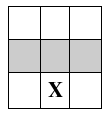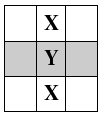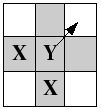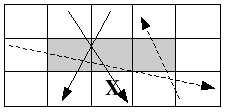










Written 30.09.2009 - Uploaded 01.10.2009 - PDF
This is the current rule document for my currently nameless Descent mod. It's not the cleares possible, as it is in a constantly developing state. The time for polishing comes much, much later.
---
Changes to victory conditions
No conquest points
Conquest points are no longer used for tracking hero team defeat. Instead, the heroes lose if, at any time, every hero is incapacitated (at zero health).
Changes to equipping
Hand occupation
This change is relatively small. When equipping a shield (or two shields), the hero player needs to declare which hand is used for wielding the shield. To indicate this in a simple way, just put the items next to each other correspondingly.
Trait requirements
In order to use a weapon of a given type, a hero needs to have at least one black die in the corresponding trait.
Changes to movement
Facing
In order to make several of the introduced concepts to work properly, all figures have facing. Indicating this should be rather simple: a figure is facing whichever direction its face is pointing at. Facing cannot diagonal at the moment, so its either up, down, left or right.
Facing has no effect on line of sight – the heroes and monsters alike are assumed to be capable of turning their heads. For purposes of spawning etc. heroes are assumed to have 360 degree LOS. It does affect line of fire and legal targets of melee attacks though, see section “Changes to combat” for more information and examples.
Changing facing is free, but can only be done during the figure's own turn. While moving, facing has no effect so there is no reason to keep track of it at that time. During a figure's own turn, facing has only limited effect on combat as well.
Blocking zones
All heroes who have a melee-weapon equipped, as well as all melee monsters establish a specific blocking zone in front of them. A blocking zone always occupies three squares: the one directly in front of the figure, and two adjacent (diagonally in front of the figure). See the example below:

As the name implies, blocking zones block movement. A figure inside another figure's block zone is only allowed to move directly backwards. This costs one additional movement point, as the figure needs to safely retreat. Additionally, entering a blocking zone voluntarily uses up all remaining movement points.

Effectively, in order to get around a melee figure, one needs to not only go around the figure itself, but also its blocking zone, making it impossible to bypass a melee character in a corridor, and more costly to get around them in general.
In case of multiple blocking zones, figures need to move away from each one. If this is not possible, the figure may not move at all. See examples below.


Changes to combat
Flank and rear
Since figures now have facing, they also have flanks and rear, which have some effect on combat. A figure's front consists of three adjacent squares in front of it (front, front-left, front-right). A figure's back consists of only the square directly behind the figure, while the remaining two squares to each side form flanks.

Figures can only attack other figures if they are in their front sector. Figures are assumed to get full use of their defense capabilities when attacked from front. Use normal rules for attacking, and shield(s) can be exhausted normally. For flanking attacks, a shield can only be used against attacks from one flank. The flank depends on which hand is wielding the shiled, so that left-handed shield can be exhausted against an attack from the left. Finally, attack from behind are deadliest. When attacked from behind, a figure cannot dodge or use shield(s). Additionally, armor is ignored when attacked from behind. Feats which enhance defense in some way may not be used. Other protective effects (such as cloak items) function normally.
Intercepting ranged (and magic) attacks
Figures are capable of intercepting ranged attacks that pass through or near them. If a ranged or magic attack's trajectory passes through a figure's blocking zone from the front side, the figure may choose to intercept it, and take the hit instead of the intended target. Intercepting must be declared before dice are rolled. If intercepting is declared, carry out the attack normally, using the intercepting figure as the new target. Notice that it is only possible to intercept attacks that affect a square (Breath and similar effects are therefore excluded). Finally, attacks made against tall targets (Demon, Dragon, Giant, Golem, Ice Wyrm, Ogre or Troll) cannot be intercepted by smaller figures unless they have Flying. In outdoor encounters, attacks against soaring figures can never be intercepted.

Ranged attacks and Aim
Figures performing ranged attack (not magic) using Aim (card or order) may choose to snipe instead of normal aim. Sniping forfeits usual benefits of aim (the re-rolls), but allows the attack to ignore any interception. Therefore, it can be used to pick targets behind enemy lines.
Line of fire
Facing also affects lines of fire (it does not affect line of sight, as stated earlier). Each figure's line of fire extends in a 90 degree arc forward. Use normal rules for determining line of sight through objects. Figures no longer block line of fire. However, they have the option to intercept attacks as per rules above.

Since figures are able to change their facing freely during their turns, line of fire has no effect for normal attacks. Guard on the other hand is affected, so it is important to indicate which way guarding characters are facing.
Follow-up attacks and facing
Certain abilities or items grant their user extras attacks, and state that such attacks are to be carried out immediately. In these situations, just like the figure is not allowed to move between attacks, it is also not allowed to change facing.
Reach, sweep and facing
Reach allows a figure to attack across one or more spaces, as per normal rules. Facing however limits to some degree, as per rules for line of fire. Also, while it is now permitted to shoot through figures, it is not permitted to use melee attacks with reach through figures.
Sweep is limited in a similar fashion, and only affects figures in legal target squares, as per rules for line of fire. Sweep with reach does go through figures.
New mechanics
Incapacitated
When a hero death would occur, they are incapacitated instead. Lay the hero figure down on its side, with its base touching the square where it took the last hit. The hero loses all remaining fatigue. Heroes adjacent to an incapacitated hero figure may take weapons, potions and any other unequipped items from it.
Healing and resurrection
Heroes capable of magic (I.e. at least one black die in magic trait) can heal and resurrect their allies. Healing/resurrection is a prolonged action (see Altar of Despair rulebook for details) and each success restores one health point to the target. The healer must be adjacent to his target in order to perform the action. In case of normal healing, the health points are gained after every roll.
When resurrecting, successes are accumulated first towards the incapacitated hero's conquest value. Only after the conquest value has been covered will the hero start gaining health. Therefore, in order to return a hero to life with one health, the healer needs to get N+1 successes, where N is the conquest value of the hero being revived. If the hero had not taken his turn during this round, he may proceed to do so in normal hero player order after revival.